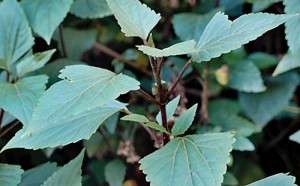Sunday Times 2
Crofton weed: Silent invader of Lanka’s highlands
Crofton weed is not a familiar plant species to Sri Lanka though it was introduced to Sri Lanka as an ornamental plant long time ago. Crofton weed is similar in appearance to Podisingho Marang, except the stem colour. My observations over the years in Sri Lanka revealed that the species has spread rapidly in highlands – the Horton Plains, Nuwara Eliya, Haggala, Talawekelle, Nanu Oya and the Knuckles Range – in the past 10 years. The main intention of this article is to provide some information and identification characters of this species to the public before it gets out of hand in upcountry areas of Sri Lanka as we do not need to get any other invader in our backyard especially the area declared as the world heritage sites.

Stem and leaves
Crofton weed botanically named as Agerantina Adenophora is a native of Mexico and present as a weed in India, Canary Island, Jamaica, Hawaii, Fiji, New Zealand and Australia. This is a rapidly spreading weed that has become a nuisance in many areas along the eastern coast of Australia. It is especially invasive on cleared lands that are not grazed, such as public reserves and open lands. This weed is prevalent in high rainfall areas of Sri Lanka.
Crofton weed is a shrubby perennial plant species with numerous chocolate brown soft woody upright branching stems emerging from underground crown and reaching a height of 1-2 m. It has broad, slightly crinkled, toothed, bright green leaves with chocolate coloured petioles. Leaves are 50-75 mm long, 25-50 mm broad and oppositely arranged on stem. The plant roots are thick, yellowish and extensive in mature plants. They have a carrot like smell when broken.
Its flowers are white, small, dense heads at the ends of the branches. Seeds are slender, angular, 2 mm long, from brown to black with fine white hairs at the tip. Mature Crofton weed plants can produce between 10,000 to 100,000 seeds per year. Seeds are very light (25,000 seeds/gram) and spread by wind or water over long distance to invade previously non-infested areas. Sometimes seeds can spread through machinery, vehicles, clothing and mud. The seeds require light to stimulate germination so that invasion commonly takes place on bare disturbed sites and rarely seen on heavily vegetated areas. Once established, seedlings tolerate shade and grow rapidly. In this way, small infestations of Crofton weed rapidly increase in size unless controlled.
 Impact
Impact
Crofton weed is aggressive in pastures in the valleys, parks, roadsides, waste areas, fence lines, grasslands and plateaus in upcountry and mid country areas of Sri Lanka.
The plant is poisonous and inflicts horses with a disease known in some parts of Australia as “Tallebudgera Horse Disease” and in New South Wales as “Numinbah Horse Sickness”, an acute pulmonary consolidation of the lungs.
Management
Control of small infestations before flowering is strongly recommended to prevent developing into large infestations which can be difficult to control. Small areas of scattered plants can be dug out with a mattock. Slashing is often used to control heavy infestations on accessible land. Regular slashing will reduce flowering and seed set, thus reducing spread by seeds. The slashed and dried plant however is still attractive and toxic to horses. Take care to keep horses away until the plants have been completely removed from the paddock.
There is a biodiversity section at the Ministry of Environment in Sri Lanka to protect, restore, and conserve the country’s biodiversity. I hope that the relevant unit should be able to assess the risk of this alien invader and make suitable arrangements to take required action to manage this emerging species from world heritage areas in highlands.
(The writer is an Invasive Plants Specialist at Mackay, Queensland, Australia)

